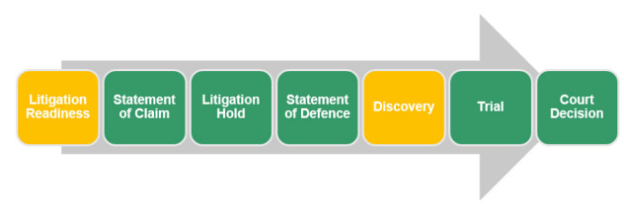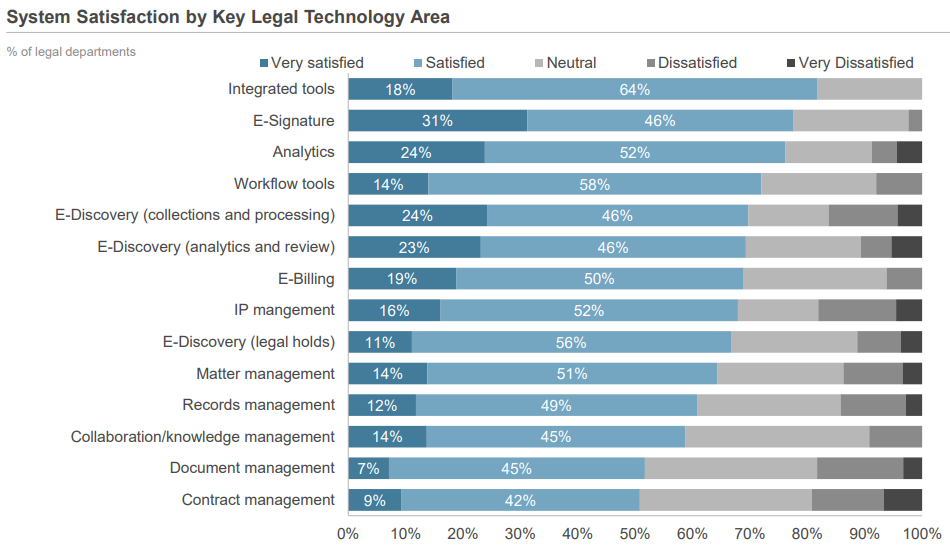Last Updated on September 23, 2024 Sarah Gayda
eDiscovery is a massive challenge for businesses today. As fines and non-compliance penalties continue to increase, eDiscovery should be a top agenda item for almost every organization. However, proactive legal eDiscovery and other compliance activities should not be partitioned off and exist in a silo. Instead, they should be part of a well-functioning business strategy across legal and IT, enabling better teamwork and collaboration.
What is eDiscovery?
eDiscovery, sometimes known as electronic data discovery or document discovery, is the process of discovery of information in electronic formats during litigation. eDiscovery encompasses electronically stored information (ESI). Examples include emails, messages, documents, accounting records and databases, CAD files and websites.

Why is eDiscovery a problem?
The eDiscovery process is expensive. Costs primarily occur at the review and processing stage of the cycle. According to AIIM, 30-70% of the eDiscovery budget is spent in the ‘review’ stage sorting out responsive documents to produce and documents to withhold.
However, the costs are even greater for non-compliance. Risk of file or content destruction after a litigation hold has been called is substantial.
Many organizations are still dependent on on-premise file shares, which creates a big problem in the case of eDiscovery. Further, many organizations do not have a proper company-wide taxonomy or classification system needed to help in the case of eDiscovery. A modern ECM system with supporting third-party applications for governance and proactive compliance provides significant help in combatting these problems before they transpire.
One example of this is through a newer, but lesser used, approach in content management called federation. Rather than creating new copies, federated document management links to the content from the ‘source’ repository, consolidating information and centralizing control. Federation helps reduce eDiscovery costs through content consolidation. To power better results, Colligo recommends utilizing metadata to search from a single view across multiple, disparate repositories that federation provides.
eDiscovery needs to be precise and you cannot leave it to chance. As such, without metadata tagged to your electronic information, you cannot guarantee that you’ve found all the pertinent files. Many knowledge workers and professionals falsely believe they can use a keyword to search for content. However, this does not hold up in an organization with hundreds of thousands (if not millions) of documents and folders, especially during eDiscovery.
eDiscovery will continue to become more important for businesses as information proliferates inside the enterprise. You should certainly considered eDiscovery while implementing or levelling up your information governance strategy.
Satisfaction with legal eDiscovery is low
Legal ediscovery affects most firms or legal departments, whether in the form of litigation or mergers and acquisitions diligence. As a result, it is critical to be prepared.
eDiscovery for law firms is among the highest area of impact, as shown in the chart below. According to the Business of Law Blog, the majority of Fortune 1000 corporations now spend about $5 million to $10 million annually on eDiscovery. Keep in mind, requirements for eDiscovery often vary by industry.
The pandemic exacerbated eDiscovery challenges. “[The pandemic impacted e-discovery as it accelerated] the explosion of communications in chat and collaboration tools without slowing the growth of email and other data … Cloud-based bespoke solutions are required to analyze this data at a reasonable cost to the client.”

What is the best approach to avoid costly penalties?
Proactive management of records and information is an important part of addressing legal eDiscovery. For 41% of in-house counsel, the most important part of managing eDiscovery in ligation is to manage information before the eDiscovery need arises.
Recommendations for proactive legal eDiscovery
We recommend law firms or corporate legal departments do the following well in advance of eDiscovery:
- Have policies for properly disposing of information without business value (destruction and disposition policies)
- Properly store, retain and manage high-value documents under your firms’ jurisdiction
- Implement a classification scheme to provide information and records management structure
However, firms also need buy in and compliance from lawyers. Often, technology or legal eDiscovery software provides the best way to achieve this.
How can firms leverage cloud technologies for eDiscovery?
Firms have have long deployed and delivered legal software behind firewalls. However, many firms have now made the shift to a cloud-based document management system. This has helped firms better deal with remote work, modernize their IT environments and provide better content access and collaboration.
Connecting to the firm’s data sources, wherever they live within the business, has become a competitive advantage. This is especially true as data security and privacy of SaaS-based solutions has come so far in the last decade.
Further, having a unified legal and compliance software system can drastically increase productivity and effectiveness. This is because the system synchronizes information assets during eDiscovery. Comparatively, disparate or stand-alone eDiscovery software for law firms may only specialize in a small piece of the eDiscovery reference model.
Firms often conduct eDiscovery after the fact. However, they need to empower workers to properly tag and file information and content on an ongoing basis, for future discovery purposes. Proper classification as emails are captured into a system like SharePoint can play a big role in this.
Correctly tagging and filing content reduces the large costs associated with eDiscovery. If you’re involved in litigation, “you will be asked to retrieve information within a stringent legal time period,” or face fines and even prosecution, according to a Business2Community article.
When companies properly tag and label their content, eDiscovery and search are much easier. Further tagging information strengthens your records management program, including retention strategies.
Metadata to the rescue
Being able to access content from anywhere is crucial. However, more important in proactive information management is having an application that allows for workers to capture content into the right location with the right metadata tags. This allows for better eDiscovery and the correct use of retention tags for lifecycle management, retention and disposition.
Metadata is a crucial component of eDiscovery. The “metadata associated with an electronic document can be just as important as the data in that document because it establishes the context in which the electronic content was created. The courts and regulators expect that the metadata associated with ESI will be kept intact,” commented John Mancini, former President of AIIM.
According to KMWorld, “Preserving the original content and metadata for electronically stored information is required in order to eliminate claims of spoliation or tampering with evidence later in the litigation.” This makes the assignment of accurate and usable metadata important, beyond the inherent search benefits.
Rich metadata support, federated Outlook/SharePoint search capabilities and offline access make it easy to provide up-to-date information. This drives collaboration and productivity for your firm, and provides protection during eDiscovery initiatives.
Managing case documents requires better Microsoft 365 integration
In addition to email management, corporate counsel and attorneys are seeking document management that lets them work rapidly in Word, PowerPoint and Excel and then save files right from Office into SharePoint. They also want to apply metadata to files for quick eDiscovery, plus pull off basic records management, assigning retention periods for documents and classifying documents by type such as a contract.
Legal teams want better integration of Office 365 with SharePoint for managing case documents. Colligo’s Email Manager, Document Manager, and Content Manager allows organizations to better follow policies and to efficiently search during discovery, ultimately helping to lower the risk and costs of non-compliance.
Pulling records and emails from the large amounts of content spanning the firm or legal department is not an easy task. Using applications that proactively enable proper classification can drastically reduce costs and time-consuming efforts.





